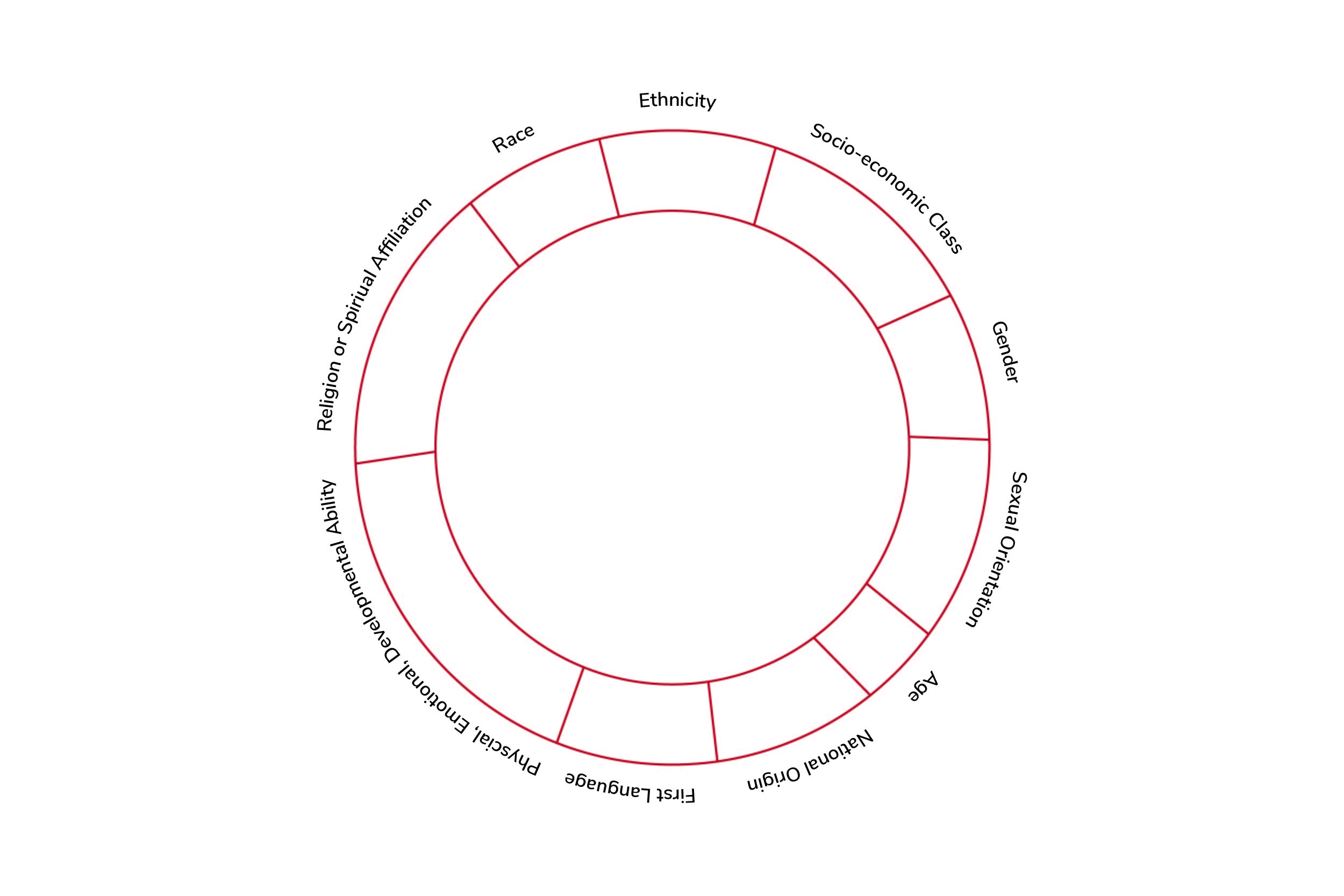Reflecting on who you are and learning about others at the same time
Activity Description
The Social Identity Wheel worksheet is an activity that encourages staff to identify and reflect on the various ways they identify socially, how those identities become visible or more deeply felt at different times, and how those identities impact the ways others perceive or treat them. The worksheet prompts staff to fill in various social identities (such as race, gender, sex, ability disability, sexual orientation, etc.) and further categorize those identities based on which matter most in their self-perception and which matter most in others’ perception of them.
Time Requirements and Recommended Group Size
• 20-25 minutes is recommended
• 4 minimum, 20-25 maximum, with space to get into small groups
Equipment and Materials
• Print the worksheets and have writing utensils available.
• Ensure the space allows for some small group interaction and/or discussion.
Instructions
1. Pass out the materials to the staff and then review the activity and instructions.
2. Ask that staff take about 7-8 minutes to fill out the Social Identity Wheel first with how they identify in each category. The Social Identity Groups worksheet can be helpful if there are questions about an identity group.
3. When staff finish filling in how they identify, they should then go through each category and assign the numbers from the center of the wheel prompts to each identity group. (You can put the same numbers in more than one group.)
• Identities you think about most often (1)
• Identities you think about least often (2)
• Your own identities you’d like to learn more about (3)
• Identities that have the strongest effect on how you see yourself (4)
Guided Questions
• In small groups of three to four (6-8 minutes): Have staff share a little bit of their wheel with others, specifically in answering the 4 center prompts about their identity. Remind them that they need only to share what they are comfortable with but that we hope they can shed light on one to two identities for each of the prompts and why they put the corresponding number in that identity group (i.e., a staff member put a #1 in the gender category).
• As a large group (5 minutes or so): What was it like completing the wheel? What was it like talking with others and sharing your responses? Other general reactions?
Facilitator Notes & Recommendations
It may be helpful to outline each identity group before the activity and staff filling this out so they have some context. The definitions are on side 1 of the worksheets, but below are a few identity groups that may solicit questions about “what to write.”
Ability
• Possession of the means or skill to do something.
• Emotional ability – Relating to a person’s emotions, characterized by intense feeling (could be related to mental health, a learning disability, or how you describe yourself as an introvert/extrovert, or nothing at all).
• Physical ability – Relating to the body as opposed to the mind.
Ethnicity
• The fact or state of belonging to a social group that has a common national or cultural tradition.
• Ethnicity is the identification of a person with a particular racial, cultural, or religious group.
Nationality
• The status of belonging to a particular nation.
• Nationality is the relationship between a person and the political state to which he belongs or is affiliated.
Social Identity Wheel
Adapted from “Voices of Discovery, Intergroup Relations Center, Arizona State University.
Social Identity Groups
Social identity groups are based on the physical, social, and mental characteristics of individuals. They are sometimes obvious and clear, sometimes not obvious and unclear, often self-claimed and frequently ascribed by others. For example, racial groupings often are ascribed as well as self-claimed. Government, schools, and employers often ask an individual to claim a racial identity group or simply ascribe one to an individual based on visual perception. Other social identities are personally claimed but often not announced or easily visually ascribed such as sexual orientation, religion, or disability status.
For the purpose of this self-examination, please identify the memberships you claim or those ascribed to you. Below are examples of social identity groupings. Feel free to use your own language for your identities. These memberships are derived from the National Intergroup Dialogue Institute, Program on Intergroup Relations, University of Michigan.
Gender
- Woman
- Man
- Transgender
- Post-Gender
Sex
- Intersex
- Female
- Male
Race
- Asian Pacific Islander
- Native American
- Latin@
- Black
- White
- Bi/Multiracial
Ethnicity
- Irish
- Chinese
- Puerto Rican
- Italian
- Mohawk
- Jewish
- Guatemalan
- Lebanese
- European-American
Sexual Orientation/Attractionality
- Lesbian
- Gay
- Bisexual
- Pan-Attractional
- Heterosexual
- Queer
- Questioning
Religion/Spirituality/Faith/Meaning
- Hindu
- Muslim
- Buddhist
- Jewish
- Christian
- Pagan
- Agnostic
- Atheist
- Secular Humanist
Social Class
Poor
Working Class
Lower-Middle Class
Upper-Middle Class
Owning Class
Ruling Class
Age
- Child
- Young Adult
- Middle-Age Adult
- Elderly
(Dis)Ability
People with disabilities (cognitive, physical, emotional, etc.)
Temporarily able-bodied
Temporarily disabled
Nation(s) of Origin/Citizenship
- United States
- Nigeria
- Korea
- Turkey
- Argentina
Tribal or Indigenous Affiliation
Mohawk
Aboriginal
Navajo
Santal
Body Type
- Fat
- Person of Size
- Thin
